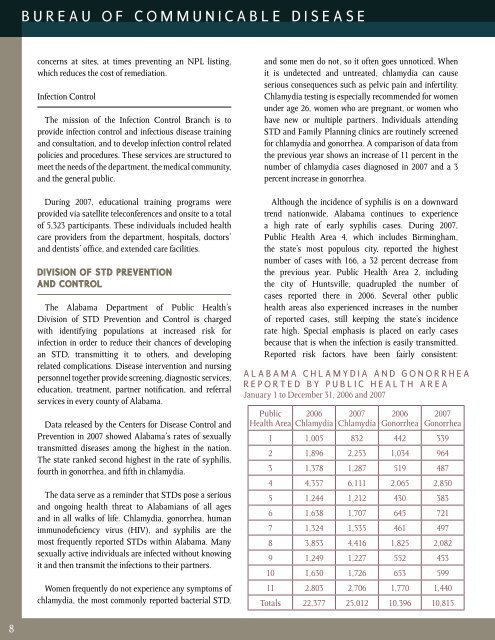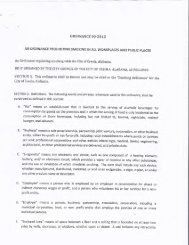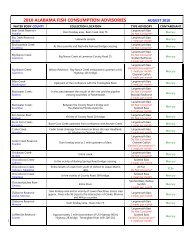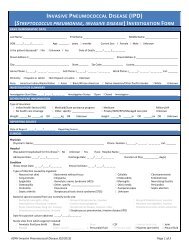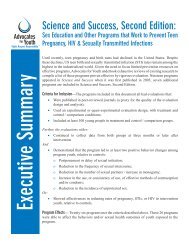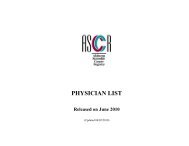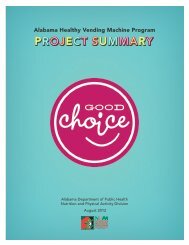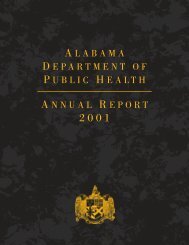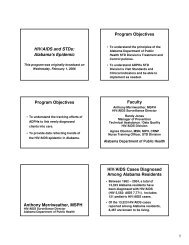2007 - Alabama Department of Public Health
2007 - Alabama Department of Public Health
2007 - Alabama Department of Public Health
You also want an ePaper? Increase the reach of your titles
YUMPU automatically turns print PDFs into web optimized ePapers that Google loves.
ureau <strong>of</strong> communicable disease<br />
concerns at sites, at times preventing an NPL listing,<br />
which reduces the cost <strong>of</strong> remediation.<br />
Infection Control<br />
The mission <strong>of</strong> the Infection Control Branch is to<br />
provide infection control and infectious disease training<br />
and consultation, and to develop infection control related<br />
policies and procedures. These services are structured to<br />
meet the needs <strong>of</strong> the department, the medical community,<br />
and the general public.<br />
During <strong>2007</strong>, educational training programs were<br />
provided via satellite teleconferences and onsite to a total<br />
<strong>of</strong> 5,323 participants. These individuals included health<br />
care providers from the department, hospitals, doctors’<br />
and dentists’ <strong>of</strong>fice, and extended care facilities.<br />
Division <strong>of</strong> STD Prevention<br />
and Control<br />
The <strong>Alabama</strong> <strong>Department</strong> <strong>of</strong> <strong>Public</strong> <strong>Health</strong>’s<br />
Division <strong>of</strong> STD Prevention and Control is charged<br />
with identifying populations at increased risk for<br />
infection in order to reduce their chances <strong>of</strong> developing<br />
an STD, transmitting it to others, and developing<br />
related complications. Disease intervention and nursing<br />
personnel together provide screening, diagnostic services,<br />
education, treatment, partner notification, and referral<br />
services in every county <strong>of</strong> <strong>Alabama</strong>.<br />
Data released by the Centers for Disease Control and<br />
Prevention in <strong>2007</strong> showed <strong>Alabama</strong>’s rates <strong>of</strong> sexually<br />
transmitted diseases among the highest in the nation.<br />
The state ranked second highest in the rate <strong>of</strong> syphilis,<br />
fourth in gonorrhea, and fifth in chlamydia.<br />
The data serve as a reminder that STDs pose a serious<br />
and ongoing health threat to Alabamians <strong>of</strong> all ages<br />
and in all walks <strong>of</strong> life. Chlamydia, gonorrhea, human<br />
immunodeficiency virus (HIV), and syphilis are the<br />
most frequently reported STDs within <strong>Alabama</strong>. Many<br />
sexually active individuals are infected without knowing<br />
it and then transmit the infections to their partners.<br />
Women frequently do not experience any symptoms <strong>of</strong><br />
chlamydia, the most commonly reported bacterial STD,<br />
and some men do not, so it <strong>of</strong>ten goes unnoticed. When<br />
it is undetected and untreated, chlamydia can cause<br />
serious consequences such as pelvic pain and infertility.<br />
Chlamydia testing is especially recommended for women<br />
under age 26, women who are pregnant, or women who<br />
have new or multiple partners. Individuals attending<br />
STD and Family Planning clinics are routinely screened<br />
for chlamydia and gonorrhea. A comparison <strong>of</strong> data from<br />
the previous year shows an increase <strong>of</strong> 11 percent in the<br />
number <strong>of</strong> chlamydia cases diagnosed in <strong>2007</strong> and a 3<br />
percent increase in gonorrhea.<br />
Although the incidence <strong>of</strong> syphilis is on a downward<br />
trend nationwide, <strong>Alabama</strong> continues to experience<br />
a high rate <strong>of</strong> early syphilis cases. During <strong>2007</strong>,<br />
<strong>Public</strong> <strong>Health</strong> Area 4, which includes Birmingham,<br />
the state’s most populous city, reported the highest<br />
number <strong>of</strong> cases with 166, a 32 percent decrease from<br />
the previous year. <strong>Public</strong> <strong>Health</strong> Area 2, including<br />
the city <strong>of</strong> Huntsville, quadrupled the number <strong>of</strong><br />
cases reported there in 2006. Several other public<br />
health areas also experienced increases in the number<br />
<strong>of</strong> reported cases, still keeping the state’s incidence<br />
rate high. Special emphasis is placed on early cases<br />
because that is when the infection is easily transmitted.<br />
Reported risk factors have been fairly consistent:<br />
<strong>Alabama</strong> chlamydia and gonorrhea<br />
reported by public health area<br />
January 1 to December 31, 2006 and <strong>2007</strong><br />
<strong>Public</strong><br />
<strong>Health</strong> Area<br />
2006<br />
Chlamydia<br />
<strong>2007</strong><br />
Chlamydia<br />
2006<br />
Gonorrhea<br />
<strong>2007</strong><br />
Gonorrhea<br />
1 1,005 832 442 339<br />
2 1,896 2,253 1,034 964<br />
3 1,378 1,287 519 487<br />
4 4,357 6,111 2,065 2,850<br />
5 1,244 1,212 430 383<br />
6 1,638 1,707 645 721<br />
7 1,324 1,535 461 497<br />
8 3,853 4,416 1,825 2,082<br />
9 1,249 1,227 552 453<br />
10 1,630 1,726 653 599<br />
11 2,803 2,706 1,770 1,440<br />
Totals 22,377 25,012 10,396 10,815<br />
8


